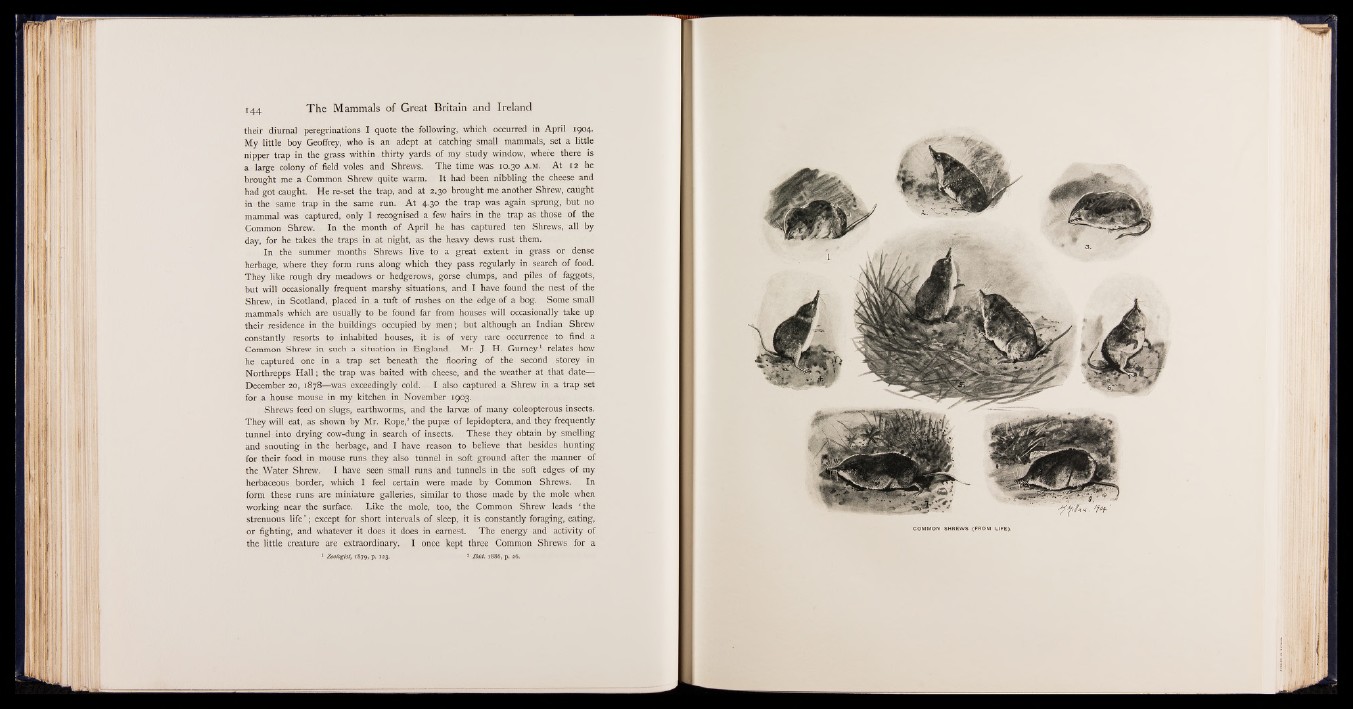
their diurnal peregrinations I quote the following, which occurred in April 1904.
My little boy Geoffrey, who is an adept at catching small mammals, set a little
nipper trap in the grass within . thirty yards of my study window, where there is
a large colony of field voles and Shrews. The time was 10.30 a .m . At 12 he
brought mé a Common Shrew quite warm. It had been nibbling the cheese and
had got caught. He re-set the trap, and at 2.30 brought me another Shrew, caüght
in the same trap in the same run. At 4.30 the trap was again sprung, but no
mammal was captured, only I recognised a few hairs in the trap as those of the
Common Shrew. In the month of April he has captured ten Shrews, all by
day, for he takes the traps in at night, as the heavy dews rust them.
In the summer months Shrews live to a great extent in grass or dense
herbage, where they form runs along which they pass regularly in search of food.
They like rough dry meadows or hedgerows, gorse clumps, and piles of faggots,
but will occasionally frequent marshy situations, and I have found the nest of the
Shrew, in Scotland, placed in a tuft of rushes on the edge of a bog. Some small
mammals which are usually to be found far from houses will occasionally take up
their residence in the buildings occupied by men; but although an Indian Shrew
constantly resorts to inhabited houses, it is of very rare occurrence to find a
Common Shrew in such a situation in England. Mr. J. H. Gurney1 relates how
he captured one in a trap set beneath the flooring of the second storey in
Northrepps Hall; the trap was baited with cheese, and the weather at that date—
December 20, 1878—was exceedingly cold. I also captured a Shrew in a trap set
for a house mouse in my kitchen in November 1903.
Shrews feed on slugs, earthworms, and the larvae of many coleopterous insects.
They will eat, as shown by Mr. Rope,2 the pupae of lepidoptera, and they frequently
tunnel into drying cow-dung in search of insects. These they obtain by smelling
and snouting in the herbage, and I have reason to believe that besides hunting
for their food, in mouse runs they also tunnel in soft ground after the manner of
the Water Shrew. I have seen small runs and tunnels in the soft edges of my
herbaceous, border, which I feel certain were made by Common Shrews. In
form these runs are miniature galleries, similar to those made by the mole when
working near the surface. Like the mole, too, the Common Shrew leads ‘ the
strenuous life ’ ; except for short intervals of sleep, it is constantly foraging, eating,
or fighting, and whatever it does it does in earnest. The energy and activity of
the little creature are extraordinary. I once kept three Common Shrews for a
1 Zoologist, 1879, p. 123. 2 Ibid. 1886, p. 26.